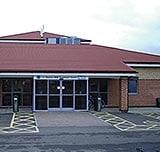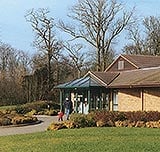
Search by region


Fitzwilliam Hospital
South Bretton, Peterborough
Milton Way, South Bretton, Peterborough, Cambridgeshire PE3 9AQ 01733308238

A transbronchial lung biopsy is a procedure that uses a bronchoscope to remove a small sample of your lung tissue.
A bronchoscope is a flexible telescope with a tiny camera so your doctor can examine your airways. Your surgeon passes a bronchoscope through your nose or mouth and down into your lungs. They then pass tiny forceps down one of your airways into your lung and take samples of your lung tissue. Saline fluid may be used to flush the area and to collect cells.
A lung biopsy allows your lung tissue to be tested for many kinds of diseases, including infections, pulmonary disease, benign tumours and polyps, and cancer. A lung biopsy can also be performed to determine the type of lung cancer and to assess the stage of a known malignancy.
A bronchoscopy with biopsy, also called a transbronchial biopsy, usually takes less than half an hour. It is usually performed in an outpatient or day case department.
If you are having a lung biopsy by open surgery, then you will be given a general anaesthetic that prevents pain and puts you to sleep through the test.
If you are having a transbronchial lung biopsy, then you won’t be put to sleep. You will be given a local anaesthetic to help numb your nose and throat and a sedative to help you relax. This is because a transbronchial lung biopsy is a minimally invasive procedure.
The recovery process after a transbronchial biopsy is relatively quick and painless.
You can expect to be able to go back to work or your daily routine after 24 hours of your transbronchial biopsy. If you had a sedative, you should avoid driving, operating machinery, and drinking alcohol for 24 hours.
It is safe to eat and drink once your ability to cough, called the cough or gag reflex, has returned, typically within two hours.
You may have some throat discomfort and pain with swallowing for a few days.
It is not recommended that you fly for one month after having a transbronchial biopsy.
You will be advised of the findings of your transbronchial biopsy and your biopsy results once available. We will discuss with you any follow-up treatment you may need.
You will receive a formal quotation price following your consultation with one of our expert surgeons when a transbronchial biopsy is the recommended procedure for you. This formal quote for your transbronchial biopsy surgery will be valid for 60 days and includes unlimited aftercare.
Ramsay is recognised by all major medical insurers. Transbronchial biopsy is covered by most medical insurance policies. We advise you to obtain written authorisation from your insurance provider before starting your treatment.
We have a number of finance options if you are paying for your transbronchial lung biopsy surgery yourself. These include:
All Ramsay hospital follow strict safety protocols to keep patients and staff safe.
A transbronchial biopsy involves inserting a flexible telescope, called a bronchoscope, through your nose to collect several pieces of lung tissue. These are analysed to find the cause of your breathing difficulties and lung problem.
At Ramsay Health Care UK, we perform transbronchial lung biopsies whenever possible rather than open biopsies so that patients benefit from low risk, fast recovery and no scar techniques.
Many of our hospitals have dedicated JAG accredited endoscopy units where transbronchial biopsy procedures are routine and appointments are available to suit you and without waiting. The prestigious JAG accreditation is awarded for high-quality and safe services for patients that meet all of the JAG quality standards.
We work alongside expert surgeons who can offer clear guidance on the best course of action for your healthcare needs.
We also offer 0% finance and fixed price packages with unlimited aftercare for peace of mind.




Clifton Park Hospital, in York, Part of Ramsay Health Care UK, has been shortlisted for the 2026 HSJ partnership award.
Ramsay Health Care UK are celebrating after being named as a Gold National Joint Registry (NJR) Quality Data Provider for the second year running, after successfully completing a national data quality audit programme for 25 hospitals offering orthopaedic procedures.
Duchy Hospital in Truro, proudly opened its state-of-the-art Imaging and Outpatient Suite representing a major investment in patient care, designed to enhance diagnostic capabilities and improve the overall experience for patients across Cornwall.
The information, including but not limited to, text, graphics, images and other material, contained on this website is for educational purposes only and not intended to be a substitute for medical advice, diagnosis or treatment. Always seek the advice of your physician or other qualified health care provider with any questions you may have regarding a medical condition or treatment.
No warranty or guarantee is made that the information contained on this website is complete or accurate in every respect. The testimonials, statements, and opinions presented on our website are applicable to the individuals depicted. Results will vary and may not be representative of the experience of others. Prior patient results are only provided as examples of what may be achievable. Individual results will vary and no guarantee is stated or implied by any photo use or any statement on this website.
Ramsay is a trusted provider of plastic or reconstructive surgery treatments as a part of our wrap-around holistic patient care. Our personal, friendly and professional team are here to support you throughout to ensure the best possible care. All procedures we perform are clinically justified.
*Acceptance is subject to status. Terms and conditions apply. Ramsay Health Care UK Operations Limited is authorised and regulated by the Financial Conduct authority under FRN 702886. Ramsay Healthcare UK Operations is acting as a credit broker to Chrysalis Finance Limited.
Ramsay Health Care UK is not currently recruiting for any roles based outside of England. If you are interested in applying for a role with Ramsay Health Care UK, please note that all available positions are advertised exclusively on our official website: https://www.ramsayhealth.co.uk/careers. Be cautious of individuals or organisations that approach you directly for remotely-based roles. Always verify the authenticity of the job offer and be careful with whom you share your personal information. For more information and advice on employment fraud, please visit: https://www.ramsayhealth.co.uk/careers/recruitment-fraud